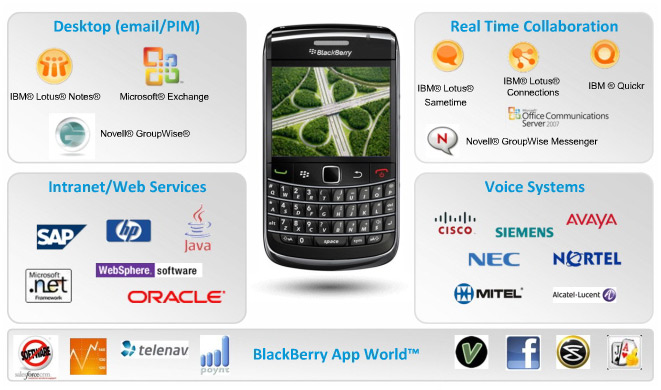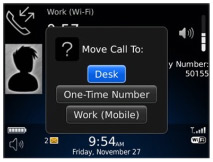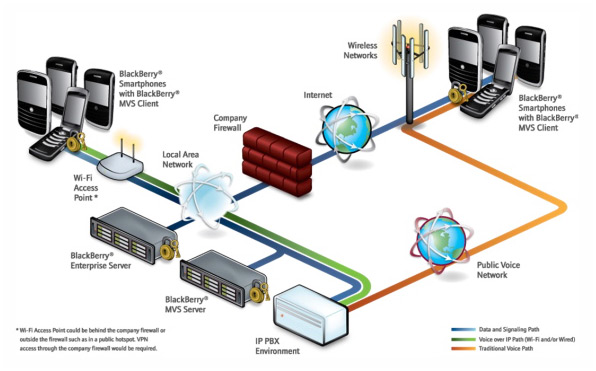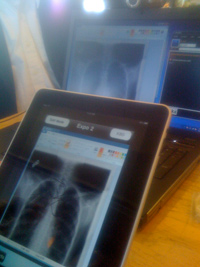BlackBerry is a unique integration of a smartphone and enterprise application infrastructure
 Further to our review of the BlackBerry Mobile Voice Solution (MVS) 4.6 release, the recently announced MVS 5.0 highlights several important new features that further strengthen RIM’s stronghold in the Enterprise.
Further to our review of the BlackBerry Mobile Voice Solution (MVS) 4.6 release, the recently announced MVS 5.0 highlights several important new features that further strengthen RIM’s stronghold in the Enterprise.
BlackBerry offers standardized integrations with leading enterprise email and instant messaging services, real-time collaboration services including the Lotus suite, Microsoft Office Communications Server and Novell GroupWise products, seven leading enterprise voice system platforms, extensive enterprise applications built using web services for SAP, .net, java, HP, WebSphere and Oracle.
RIM recently launched the BlackBerry App World and is rapidly growing its retail capabilities of apps for all manner of enterprise processes and workflows.
Despite all these expanding capabilities, the real power of the BlackBerry business is the chain that links its devices to a service provider’s data operation, its own data networks and servers and an enterprise server (BES) in service in tens of thousands of enterprise networks today. This extensive value chain is very sustainable over time and not easily reproduced.
Into this framework and value chain, the MVS offers an extension of the BES-operator-device method to deliver mobile UC functionality in a way that BlackBerry administrators appreciate and understand.
The new release of MVS, announced at the WES 2010 Conference this week in Orlando FL incorporates five significant, new features:
- Built-in Voice over Wi-Fi support
- Flexible call move feature
- Management of outgoing call selection
- High availability configurations
- Platform development environment
 Built-in Voice over Wi-Fi support: Until recently this was a feature supported only by a few of the mobile UC vendors notably Agito. Now, MVS customers get the same dialer experience in the cellular service mode as they do in the Wi-Fi mode. This seamless flow between the Wi-Fi and cellular modes greatly improves the user experience but enabling elegant integration features like the call move feature.
Built-in Voice over Wi-Fi support: Until recently this was a feature supported only by a few of the mobile UC vendors notably Agito. Now, MVS customers get the same dialer experience in the cellular service mode as they do in the Wi-Fi mode. This seamless flow between the Wi-Fi and cellular modes greatly improves the user experience but enabling elegant integration features like the call move feature.
Flexible call move feature: allows users to migrate their calls to the desk phone a one-time number or to the cellular client (if in a Wi-Fi call).
Management of outgoing call selection: users can set their preferences to require all outgoing calls to try the Wi-Fi connection first (unless not available), and thereby reduce their total wireless minutes consumed.
High availability configurations: now the MVS server can be deployed in a redundant configuration for maximum uptime of mobile UC service.
 Probably the most important new feature is the release of the MVS Development Environment so third party developers can create their own SIP-based integrations with the MVS. RIM knows how to build and support an app development environment. The program allows third parties to create their own MVS integrations, test them with full support of BlackBerry and market them in a joint marketing initiative.
Probably the most important new feature is the release of the MVS Development Environment so third party developers can create their own SIP-based integrations with the MVS. RIM knows how to build and support an app development environment. The program allows third parties to create their own MVS integrations, test them with full support of BlackBerry and market them in a joint marketing initiative.
The program includes a detailed testing program with test cases for vendor testing, help desk support, interoperability testing lab for BlackBerry verification of integration success, RIM handles interoperability with the various BlackBerry devices and joint go-to-market activities.
Overall, the MVS uniquely leverages the BlackBerry Enterprise Server and delivers mobile UC services to the BlackBerry users of the customer. MVS 5.0 accelerates market penetration by enabling third parties to align their technologies and customer value with BlackBerry which of course strengthens the BlackBerry’s role in mobile UC deployments. However, the MVS does not work with other leading platforms such as the iPhone, Android or Nokia devices which creates opportunities for the other product vendors to complement an MVS implementation or compete for a BlackBerry customer’s mobile UC business with a serious advantage and an enterprise-wide value proposition.









